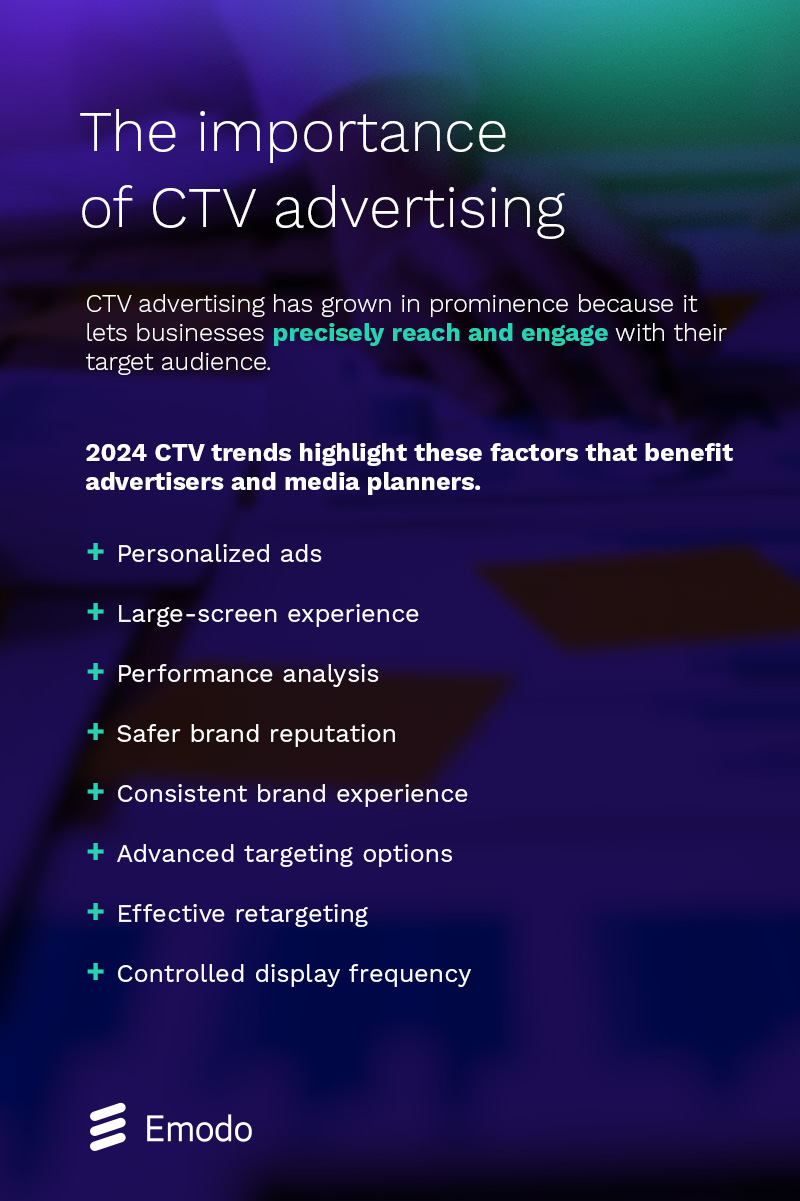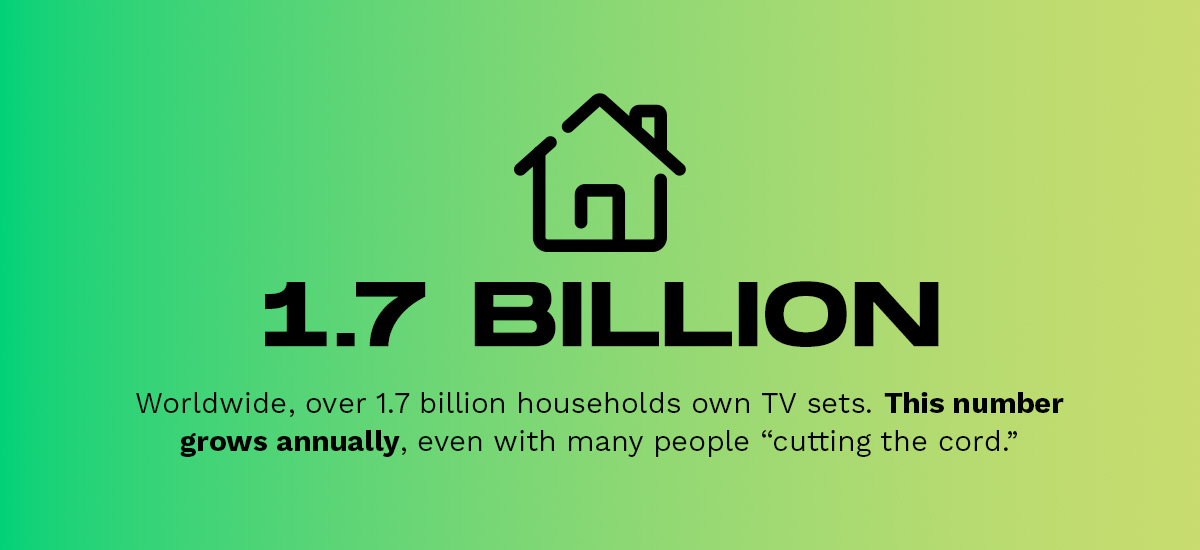Connected TV, or CTV, refers to televisions that connect to the internet. CTV allows viewers to enjoy online content from apps and streaming services, through smart TVs, set-top boxes or game consoles. It has become increasingly popular due to its convenience and wide range of content options. Over 80% of U.S. households own at least one internet-connected TV device. And that’s not the only reason advertisers and publishers are taking advantage of connected TV advertising trends.
While CTV trends in 2024 have much to do with consumer behavior, advertising technology continues to evolve. These insights will be valuable for marketers and publishers looking to benefit from CTV’s advertising reach and engagement potential.
Before exploring CTV trends, we first need to discuss why CTV is in the spotlight, why it’s better than over-the-top advertising and the shift away from linear TV advertising.
The importance of CTV advertising

Like linear TV ads, CTV ads appear on smart TVs or other CTV platforms as people watch TV shows or movies. However, CTV ads can be more targeted than those delivered via satellite or cable TV. CTV advertising has grown in prominence because it lets businesses precisely reach and engage with their target audience. 2024 CTV trends highlight these factors that benefit advertisers and media planners.
- Personalized ads: With CTV, advertisers can leverage data to understand viewer preferences, much like digital or social media advertising, ensuring the desired audience sees their ads when they’re likely to buy something. This tactic makes ads more relevant and increases the chances of capturing viewers’ attention.
- Large-screen experience: Delivering CTV ads on TV screens can enhance their impact, compared to those seen on phones, tablets and laptops. Brands can provide a captivating and immersive environment to showcase their products or services.
- Performance analysis: Advertisers can track and analyze CTV ads’ performance, gaining insights into metrics like ad impressions, completion rates and conversions. This data optimizes campaigns and maximizes the return on investment.
- Safer brand reputation: Before launching CTV ads, brands can pick specific programs or placements for them to appear. This step is vital in an oversaturated advertising landscape to avoid showing ads to the wrong audience at an inappropriate time.
- Consistent brand experience: CTV ads integrate well with omnichannel marketing strategies. This ability gives businesses a unified brand experience for their audience across different platforms and channels.
- Advanced targeting options: Since CTV ads offer similar personalized targeting capabilities to social media ads, marketers can use research data for precise audience segmentation, potentially resulting in more successful future campaigns.
- Effective retargeting: CTV ads drive brand awareness that relates to website actions from desktop or mobile devices. For example, imagine a viewer sees a CTV ad that piques their interest. They may make a mental note to check out the brand’s website, but seeing the ad again on their laptop or phone while browsing the internet may give them the final push to make a purchase or book an appointment.
- Controlled display frequency: Businesses can regulate CTV ads’ display frequency. People who see ads too frequently may tune out or get annoyed. Thus, capping helps with brand experience and lowers ad blindness and tiredness.
Why CTV is better than OTT

Worldwide, over 1.7 billion households own TV sets. This number grows annually, even with many people “cutting the cord.” The big-screen experience is the same, whether families and friends stream a movie or watch a series on cable.
Streaming companies are free to bypass TV providers, avoiding concerns like a traditional broadcast schedule or geographic limitations. Viewers can access this “over-the-top” content — including ads — at any given point, whether they stream on CTV or other OTT devices.
The ad experiences are relatively similar across CTV and OTT streaming devices. However, though CTV falls under the OTT umbrella, the trends in CTV advertising indicate the benefits of using this platform over OTT platforms.
- Viewer experience: People who view CTV content in a relaxed environment have a higher tolerance for watching ads. CTV ads typically give a more traditional experience than watching ads on smaller devices.
- Engaging with cord-cutters: CTV ads are an ideal way for brands to engage with audiences who no longer subscribe to cable or satellite TV, but still use streaming services through their TV sets.
- Advanced targeting abilities: CTV and OTT ads have precise targeting capabilities. However, data from CTV is generally more accurate, since it doesn’t come from multiple devices like OTT. Advertisers deliver personalized ads to specific audiences and households, increasing their campaigns’ relevance and effectiveness.
- Longer ads: CTV platforms follow a more traditional TV-like experience, which means the ads are longer. Since viewers cannot easily skip CTV ads, you’ll have a better chance of getting your message across to your audience.
- Wide range of content: CTV platforms include popular streaming services like Netflix, Hulu and Disney+, all of which allow viewers to access a vast library of entertainment options.
Linear TV advertising trends
To understand CTV advertising trends for 2024, you must first consider what has happened with conventional broadcast television. Most cable and satellite customers can access hundreds of channels that schedule and air advertisements during specific time slots. Viewers see these ads sequentially, following a linear schedule. One notable difference from CTV is that all households watching the same show or movie see the same linear TV ads simultaneously.
Linear TV ads have characteristics that cater to diverse market needs with unique pros and cons.
- Non-skippable ads: The longer ad duration and non-skippable nature of TV ads improve the chances of viewers engaging with the content. Unfortunately, viewers often take advantage of these moments to get up and do other activities until the show returns, which lessens the ad experience’s effectiveness.
- Household reach: Linear TV and CTV ads can reach multiple people within a household, delivering one message to many viewers. While CTV has a similar co-viewing challenge as linear TV, it is still possible to target CTV ads based on expected viewer performances.
- Marketing mix: While more than 110 million CTV users are Gen Z and millennials, older generations still gravitate toward linear TV, allowing advertisers to tap into underrepresented audiences.
- Trustworthiness: Linear TV ads are subject to stricter regulations, which means brands benefit from a controlled and trustworthy space for their ads. Viewers perceive ad content on linear TV as more reliable than their digital counterparts, and this trust can enhance brand credibility.
- Major live events: Though digital platforms are gaining traction for live broadcasts like awards shows and sports, linear TV remains the host for most of these events, providing communal viewing experiences for many.
- Measurements: Measuring linear TV ads’ impact can be challenging. Unlike with CTV ads, there aren’t easy metrics to obtain detailed information on who viewed ads, how long they watched the ads and what actions they took afterward.
Despite the benefits of linear TV ads, the traditional linear TV audience has sharply declined as viewers choose more on-demand and personalized content consumption from digital platforms and streaming services. Marketers and publishers must adapt their advertising strategies, including CTV ads, to stay relevant and reach their target audiences. These are the latest TV advertising trends.
- While household names use linear TV and CTV ads for a mass-market reach, other marketers are more conservative with their budgets, allocating ad spend to maximize ROI.
- Linear TV ads will experience price increases to make up for the networks’ bottom line due to lower viewer numbers, driving more advertisers to look for other options.
- Linear TV ad spending will decrease, while CTV ad spending will increase in the next few years.
- Linear TV ads’ future hinges on marketers’ ability to adapt their strategies to align with the shifting dynamics of viewer behavior and new entertainment technologies.
One significant reason linear TV is still relevant is live sports broadcasting and the occasional political or cultural event. These seasons may see a surge in viewership and an influx of ads from big brands. However, linear TV viewership numbers will continue declining as more services add sports streaming rights to their platforms.
Latest CTV trends
Those who seek an increased ROI from their advertising campaigns should consider these CTV trends for 2024 and beyond when planning their next campaigns.
CTV viewership numbers continue to grow

With more of the population ending their cable and satellite subscriptions in favor of streaming platforms, CTV viewer numbers continue increasing. More than half of U.S. adults stream videos via CTV. This trend encourages streaming services to offer ad-supported tiers at a lower cost, allowing viewers to access content at a significantly reduced price. These lower-cost options provide less of a barrier to entry for new consumers while allowing brands to promote their products and services to their ideal target audience.
CTV ad spend is increasing
As people switch to streaming services, more brands are following suit and spending more of their advertising budget on CTV ads. A larger audience means a higher potential reach to target audiences, and many companies are willing to pay higher rates for ad placements. The prices for ad space will continue increasing as companies enter the CTV advertising space, causing more competition for top spots.
Companies have more precise targeting capabilities
With the help of experienced service providers, companies are becoming more sophisticated about segmenting their target audiences to deliver personalized, relevant ads. Here are examples of audience segments in CTV ads.
- Demographics: These include factors like household composition, gender, age, education level and household income.
- Geographics: Marketers can also segment their audiences into specific regions, cities, towns or ZIP codes.
- Behaviors: Advertisers can analyze their ideal customers’ previous interactions with their brand, their content consumption patterns, app usage and search history.
- First party: This data comes directly from a company’s customer base.
- Context: This segmentation relies on the program, genre or streaming platform users watch.
- Retargeting: When people have previously interacted with a brand or website, brands use the opportunity to re-engage them with retargeting ads.
Millennials and Gen Z are quick to adopt CTV
Younger generations are most likely to use CTV devices, making it an excellent advertising avenue for brands catering to these demographics. Gen Z is the largest age group using subscription services, with video streaming being the most popular subscription choice. This trend could be a combination of younger generations preferring to watch on-demand content and picking up new technology faster and easier than older generations.
CTV ads are becoming more interactive
Interactive ads are an excellent way to increase engagement. Since viewers presumably use reliable internet connections for streaming services, marketers and publishers can get creative with their ads and viewer experiences. CTV will feature more shoppable and pause screen ads that allow people to complete transactions on devices such as mobile phones. These direct purchasing capabilities — typically found with other types of OTT ads — can shorten the conversion funnel and path to purchase.
User experience remains the top priority for ads
As CTV ads become more advanced and interactive, advertisers must keep user experience top of mind. Interactive ad components must be relevant, to the point and easy to use. The average viewer may tolerate an ad disrupting their favorite episode if it’s engaging, creative or funny.
Here are three things to consider to improve the user experience.
- Nonintrusive ad formats: Choose ad formats that do not disrupt the viewing experience. Overly long or frequent ad placements may frustrate viewers.
- High-quality production: CTV ads should be professional, visually appealing and have good audio quality. Visually engaging ads with a clear message are more likely to catch viewers’ attention and leave a positive impression.
- Seamless ad transitions: Create smooth transitions between content and ads. Consider fade-ins or other visually pleasing techniques rather than abrupt or jarring transitions that can adversely affect the user experience.
Make the future of CTV bright and promising with Emodo
At Emodo, we believe in creating immersive, dynamic CTV ad experiences that are richer and personalized for your relevant audience. We help advertisers and publishers form memorable connections with consumers through impactful advertising. When you work with us, you will benefit from a wide range of research and innovation.
Are you ready to bring your vision to life with your CTV ad campaigns? We would love to hear from you! Contact our team today and we will get in touch.
MORE LIKE THIS



